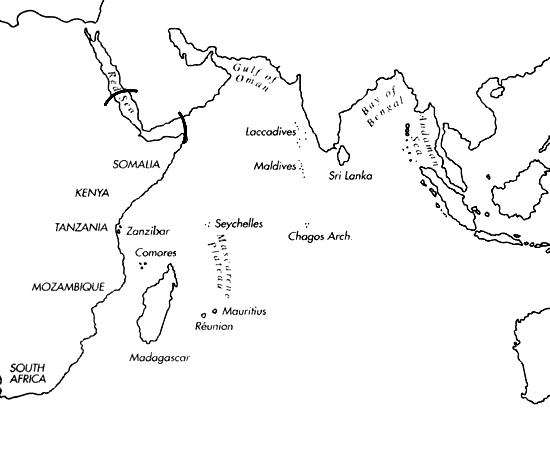
Skip Navigation Links
View access keys for this site.

Range: Central and S. Red Sea; Aden to Kuria-Muria Is., Oman.
Description: Small to moderately small, usually moderately light to moderately solid; shells from Port Sudan somewhat lighter than shells from other localities. Last whorl conical to broadly or ventricosely conical; outline convex at adapical fourth to two-thirds, straight below; left side may be concave near base. Shoulder angulate. Spire low to high, outline concave to almost straight. Larval shell of about 2 whorls, maximum diameter 0.6-0.8 mm. Teleoconch sutural ramps flat to slightly concave adaxially, with 1-2 increasing to 3-4 or sometimes 5-6 spiral grooves. Last whorl with variably wide spiral grooves toward base; ribbons between narrow or grading to ribs at base.
| Shell Morphometry | ||
|---|---|---|
| L | 16-35 mm | |
| RW | 0.05-0.15 | |
| (L 16-31 mm) | ||
| RD | 0.60-0.75 | |
| PMD | 0.80-0.90 | |
| RSH | 0.09-0.26 | |
Ground colour white to bluish white. Last whorl with spiral rows of light reddish or dark brown dots, spots or bars that may fuse into flecks, axial blotches and spiral bands, below shoulder, within adapical and abapical third. Larval whorls white to brown; about 2 adjacent postnuclear sutural ramps of the same colour. Following sutural ramps variably maculated with light to dark brown radial streaks, spots or blotches. Aperture brown, white, violet or brownish violet, sometimes brown only deep within.
In the form from Massawa (see Discussion), radular teeth with an adapical barb opposite a blade; serration extending from the posterior end of the barb along the blade, with a cusp a short distance posterior to the row of denticles; shaft waisted centrally; base with a spur (Rolán & G. Raybaudi, in press). Very similar teeth were found in C. erythraeensis from Port Sudan (Bandel, 1984).
Habitat and Habits: Shallow water, to about 15 m. Shells from the Arabian coast from Jeddah to N. Yemen "in very quiet shallow lagoons, in sand and amongst eel-grass roots" (Sharabati, 1984).
Discussion: C. erythraeensis is similar to C. jickelii, C. angioiorum, and C. nigromaculatus. C. jickelii grows larger (50 mm vs. 35 mm), has a generally narrower last whorl, (RD 0.58-0.64), and a generally lower spire (RSH 0.09- 0.16); its spiral rows of brown markings are arranged in groups rather than evenly distributed over the last whorl, and the markings are larger. C. angioiorum also attains larger size and has a generally narrower last whorl (RD 0.56-0.64), its shoulder is subangulate, and the spiral rows of brown markings on its last whorl are also arranged in groups rather than being evenly distributed. For comparison with C. nigromaculatus, see the Discussion of that species. Shells almost identical to the lectotype of C. erythraeensis (Pl. 37, Fig. 5) occur along the coast of Eritrea and in the Dahlak Archipelago (Pl. 37, Figs. 8, 9). C. adustus (Pl. 37, fig. 7), C. couderti, and C. quadratomaculatus (Pl. 37, Fig. 6) refer to colour variants probably from this area. C. induratus as represented by Reeve's original figure (Pl. 37, Fig. 13) is nearly identical to a local form of C. erythraeensis from Port Sudan (Pl. 37, Fig. 14); shells of this form are somewhat less solid than those of the other forms and have a pale blue ground colour. Shells described as C. dillwynii (Pl. 37, Figs. 16, 17) may belong to a C. erythraeensis population living from Jeddah southwards to Yemen (Pl. 37, Figs. 18, 19); they differ from the type specimens of C. dillwynii only in a slightly more concave spire outline, slightly more convex outline of the last whorl and somewhat more pronounced spiral grooves on the sutural ramps. Specimens attain adult length of 24-35 mm (types of C. dillwynii: 27-31 mm; range of C. erythraeensis: 16-29 mm) and cannot be separated from C. erythraeensis at the species level. Unnamed local forms of C. erythraeensis are known from Aden and from Massawa, Eritrea (Pl. 37, Figs. 11, 12). Shells from the former area have somewhat narrower last whorls than those of the typical Eritrean form (RD 0.63-0.67 vs. 0.65-0.75), while specimens from Massawa reach only 16-24 mm in length (vs. 20-28 mm in typical Eritrean form), have beige to brown apices, and their apertures are white or light brown deep within. Shell morphometry (RD 0.63- 0.71: PMD 0.85-0.89: RSH 0.13-0.22), sculvture and colour pattern favour their inclusion in C. erythraeensis.

C. erythraeensis range map
This section contains verbatim reproductions of the accounts of 316 species of Conus from the Indo-Pacific region, from Manual of the Living Conidae, by Röckel, Korn and Kohn (1995). They are reproduced with the kind permission of the present publisher, Conchbooks.
All plates and figures referred to in the text are also in Röckel, Korn & Kohn, 1995. Manual of the Living Conidae Vol. 1: Indo-Pacific Region.
The range maps have been modified so that each species account has it own map, rather than one map that showed the ranges of several species in the original work. This was necessary because each species account is on a separate page on the website and not confined to the order of accounts in the book.
Return to framed version (returns to search page)